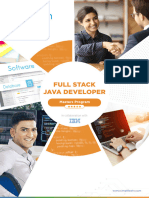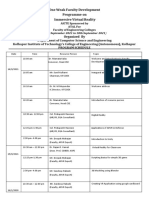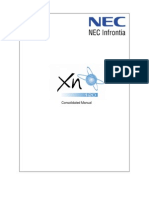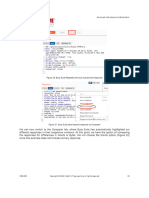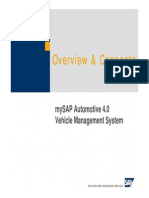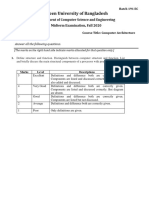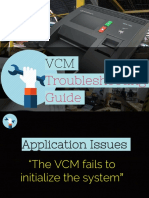Clean Roadmap: Java Full Stack Developer
(0-2 Years Experience) with React.js
This roadmap focuses on building a solid understanding of both the funda-
mental and modern technologies required for a full-stack role, emphasizing
practical application and industry relevance.
Phase 1: Foundational Core Java & Computer Science
(0-3 Months)
Goal: Master the absolute basics of Java and essential CS concepts.
Key Technologies/Concepts:
• Core Java (Deep Dive):
– OOPs: Classes, Objects, Encapsulation, Inheritance, Polymorphism,
Abstraction. Understand their practical application and design princi-
ples.
– Data Types & Operators: Primitives, Wrappers, Type Casting.
– Control Flow: Conditionals (if-else, switch), Loops (for, while,
do-while).
– Methods: Method overloading, overriding.
– Arrays & Strings: Basic manipulation.
– Collections Framework: List (ArrayList, LinkedList), Set (HashSet,
TreeSet), Map (HashMap, TreeMap). Understand their time complexities
and use cases.
– Exception Handling: try-catch-finally, throws, checked vs. unchecked
exceptions, custom exceptions.
– I/O Streams: File I/O (BufferedReader, BufferedWriter).
– Multithreading & Concurrency (Basics): Thread, Runnable, synchronized
keyword. Focus on understanding race conditions and basic synchroniza-
tion.
– Java 8+ Features: Lambda Expressions, Stream API, Optional. Cru-
cial for modern Java coding style.
1
�• Data Structures & Algorithms (DSA) in Java:
– Fundamentals: Arrays, Linked Lists, Stacks, Queues, Trees (Binary,
BST), Hash Tables.
– Algorithms: Sorting (Merge, Quick), Searching (Binary), Recursion,
BFS/DFS (for trees/graphs).
– Time & Space Complexity: Always analyze your solutions using Big
O notation (O(n), O(n log n), etc.).
– Practice: LeetCode (Easy & Medium), HackerRank, GeeksforGeeks.
• Computer Science Fundamentals:
– Operating Systems (OS): Processes vs. Threads, CPU Scheduling
(concepts), Memory Management (virtual memory, paging).
– Database Management Systems (DBMS):
∗ SQL (Crucial): SELECT, INSERT, UPDATE, DELETE, JOIN (INNER,
LEFT, RIGHT), GROUP BY, HAVING, subqueries.
∗ Concepts: ACID properties, Normalization (1NF, 2NF, 3NF), In-
dexing.
– Computer Networks (CN): OSI Model, TCP/IP, HTTP/HTTPS,
DNS (basic understanding).
• Version Control:
– Git & GitHub: Learn commit, push, pull, branch, merge, pull
requests. All code/projects must be on GitHub.
Phase 2: Backend Development - From Basics to Modern
Frameworks (3-9 Months)
Goal: Understand how web applications are built in Java, from low-level
interaction to high-level frameworks.
Key Technologies/Concepts:
• Database Connectivity (JDBC):
2
� – Focus: Understand how Java connects to databases directly using JDBC
API (Connection, Statement, ResultSet, PreparedStatement). This
provides crucial insight into ORMs like Hibernate.
– Action: Build a small command-line application that performs CRUD
operations using JDBC.
• Web Basics (Servlets & JSP):
– Servlets:
∗ Focus: Understand the Servlet lifecycle, HttpServletRequest, HttpServletResponse,
HTTP methods, session management. This is foundational for under-
standing how web requests are handled on the server side, even if you
won’t use them directly in modern apps.
∗ Action: Create a simple "Hello World" Servlet, then a simple form
submission handler.
– JSP (JavaServer Pages - Basic):
∗ Focus: Understand how JSPs allow embedding Java code in HTML
for dynamic content. Less used now, but good for historical context
and basic rendering ideas.
∗ Action: Render dynamic data from a Servlet to a JSP page.
– Deployment: Understand WAR files and deploying to a Servlet Con-
tainer like Apache Tomcat.
• Object-Relational Mapping (ORM) - Hibernate:
– Focus: Understand why ORMs are used (mapping Java objects to
database tables).
– Hibernate Core: @Entity, @Table, @Id, @Column, @GeneratedValue.
– Relationships: @OneToOne, @OneToMany, @ManyToOne, @ManyToMany.
Crucial for complex data models.
– HQL (Hibernate Query Language): Basic querying.
– Action: Rebuild your JDBC application using Hibernate for data per-
sistence.
• Spring Framework (The Ecosystem King):
– Spring Core:
3
� ∗ IoC (Inversion of Control) & DI (Dependency Injection):
This is the most critical Spring concept. Understand it deeply. How
Spring manages object lifecycle and dependencies (@Autowired, @Component,
@Service, @Repository).
∗ Spring Beans: Lifecycle, scopes.
– Spring MVC:
∗ Focus: Building traditional web applications (Controllers, Views,
Model attributes). Lays groundwork for REST APIs.
∗ Action: Build a simple web app using Spring MVC with Thymeleaf/JSP
as view layer.
– Aspect-Oriented Programming (AOP):
∗ Focus: Understand concepts like Aspect, Join Point, Pointcut, Ad-
vice (Before, After, Around). Good for cross-cutting concerns like
logging, security.
∗ Action: Implement simple logging using Spring AOP.
– Spring Boot (Accelerated Development):
∗ Focus: Build production-ready Spring applications rapidly with min-
imal configuration. Understand auto-configuration and "starters."
∗ RESTful APIs:
· Focus: Designing and implementing REST endpoints (@RestController,
@GetMapping, @PostMapping, etc.).
· HTTP Methods & Status Codes: Proper usage (200, 201, 400,
404, 500).
· JSON Handling: Sending/receiving JSON data.
∗ Spring Data JPA: Simplifies data access layer with minimal code.
· Focus: JpaRepository, custom query methods, @Query annota-
tion. This abstracts away much of direct Hibernate interaction.
∗ Spring Security (Authentication & Authorization):
· Focus: Implement user authentication (username/password, JWT)
and role-based authorization. Absolutely essential for real-world
apps.
∗ Validation: Use javax.validation with Spring.
∗ Global Exception Handling: @ControllerAdvice.
– Build Tool:
∗ Maven or Gradle: Master dependency management, building JAR/WAR
files, running tests.
4
�Phase 3: Frontend Development with React.js (6-12
Months)
Goal: Build interactive and responsive user interfaces that consume your
Java backend APIs.
Key Technologies/Concepts:
– HTML5 & CSS3:
∗ HTML: Semantic HTML, forms, basic structure.
∗ CSS: Selectors, Box Model, Flexbox, Grid (for layout), Responsive
Design (media queries).
∗ CSS Frameworks (Optional but Recommended): Tailwind CSS
or Bootstrap for rapid styling.
– JavaScript (ES6+):
∗ Fundamentals: Variables (let, const), Data Types, Operators,
Control Flow, Functions.
∗ Asynchronous JS: Callbacks, Promises (.then().catch()), async/await.
Crucial for API calls.
∗ DOM Manipulation: Basic interaction with HTML elements.
∗ Modern JS Features: Arrow functions, Destructuring, Spread/Rest
operators, Modules (import/export).
– React.js (Deep Dive):
∗ Core Concepts: Components (functional), JSX, Props, State, Com-
ponent Lifecycle.
∗ Hooks: useState, useEffect, useContext, useRef, custom hooks.
Master these!
∗ State Management:
· useState, useContext for local/component-level state.
· Redux / Zustand / React Context API (Advanced): For
global state management in larger applications. Choose one and
understand its principles.
∗ Routing: React Router DOM (client-side routing).
∗ API Integration:
· Fetch API or Axios: Making HTTP requests to your Java back-
end.
· Handling API responses (JSON parsing, error handling).
∗ Forms: Controlled components, form validation.
5
� ∗ Component Libraries (Optional): Material UI, Ant Design, Chakra
UI for pre-built components.
– Frontend Tooling:
∗ Node.js & npm/yarn: For package management.
∗ Webpack/Vite: Understand that these bundle your React app (of-
ten abstracted by create-react-app or Vite).
Phase 4: Integration, Deployment & Advanced Con-
cepts (9-24 Months)
Goal: Bring frontend and backend together, deploy applications, and un-
derstand broader architectural concepts.
Key Technologies/Concepts:
– Full Stack Integration:
∗ CORS (Cross-Origin Resource Sharing): Understand and re-
solve CORS issues when frontend and backend are on different origins
(Spring Security setup for CORS).
∗ API Contracts: Define clear API endpoints, request/response for-
mats (JSON).
– Containerization (Docker):
∗ Focus: Package your Java backend and React frontend into Docker
images.
∗ Dockerfile: Learn to write Dockerfile for Spring Boot and React
applications.
∗ docker-compose: Orchestrate multi-container applications (e.g., Spring
Boot + React + MySQL). Highly valuable skill.
– Basic Cloud Deployment:
∗ Focus: Deploy a simple full-stack application (e.g., your Spring Boot
backend + React frontend) to a cloud platform.
∗ Platform: AWS (Elastic Beanstalk, EC2, RDS) or Render/Heroku
(simpler for initial deployment).
– Testing (Beyond Unit Testing):
∗ Backend: Integration Tests for Spring Boot.
∗ Frontend: Jest/React Testing Library for Unit/Integration tests.
– Microservices Architecture (Conceptual):
6
� ∗ Focus: Understand the concept, benefits, and challenges of microser-
vices vs. monolithic architecture.
∗ Spring Cloud (Optional, for advanced learners): Service Dis-
covery (Eureka), API Gateway (Zuul/Gateway).
– Message Queues (Optional):
∗ Focus: Basic understanding of Kafka or RabbitMQ for asynchronous
communication (e.g., email notifications, complex processing).
– Caching (Optional):
∗ Focus: Understand caching principles (e.g., Redis) to improve appli-
cation performance.
Project Ideas for Your Portfolio (0-2 Years Experience):
– Project 1: Simple Blog/CRUD Application (Backend Focus)
∗ Backend: Core Java, JDBC (initial), then transition to Hibernate,
then Spring Data JPA with Spring Boot. RESTful API.
∗ Frontend: Simple HTML/CSS/JS or basic React for consuming the
API. Database: MySQL/PostgreSQL.
– Project 2: E-commerce Backend API
∗ Backend: Spring Boot, Spring Data JPA, Spring Security (JWT
authentication), REST APIs for products, orders, users. Database:
MySQL/PostgreSQL. Features: Search, Pagination, Filtering, User
Roles.
– Project 3: Interactive Task Manager / Social Media Feed (Full
Stack)
∗ Backend: Spring Boot, Spring Data JPA, Spring Security. APIs for
creating/managing tasks/posts, user profiles, comments. Frontend:
React.js (components, hooks, state management, React Router), con-
sume backend APIs. Deployment: Dockerize both backend and
frontend, deploy to a simple cloud platform.
General Tips for Success:
– Practice Daily: Coding challenges (DSA), building small features for
your projects.
– Code Quality: Write clean, readable, well-commented code. Follow
Java coding conventions.
7
�– Understand "Why": Don’t just learn syntax; understand the design
principles and trade-offs behind each technology.
– Debugging Skills: Learn to effectively use your IDE’s debugger (In-
telliJ IDEA is highly recommended for Java).
– Build a Strong GitHub Profile: All your projects should be well-
documented on GitHub.
– Networking: Connect with professionals on LinkedIn, attend webi-
nars/meetups. Seek referrals.
– Interview Preparation: Consistent practice for technical, DSA, and
behavioral interviews.
– Stay Curious: The tech landscape evolves. Keep learning!

















































